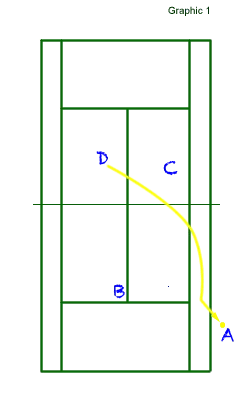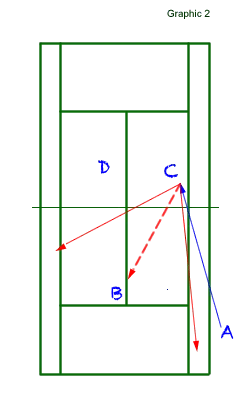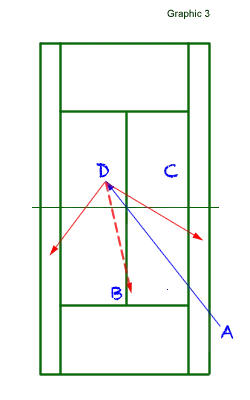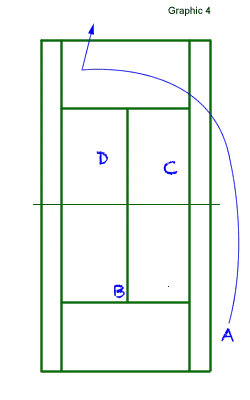Playing the Wide Ball against Both-Up Formation
This is one of the toughest situations in the game of doubles: you (A) are chasing a wide ball that gets you past the doubles alley (see graphic 1 below) – your partner (B) has to cover the remaining court (which is a big opening for one player); you must hit this ball while on the run and have to hit the best shot that not only prevents a put-away from your opponents (C and D, attacking at the net) but it also allows your partner to defend the court until you gain your position.

The purpose of this article is to analyze the best options that you have when facing a situation like this: wide ball when the opposing team attacks – where and how to hit the wide ball.
It is very important to specify the position that your partner should take while you chase the wide ball:
As soon as your partner (B) sees you (A) moving wide, she should back up (previously inside the service court, closer to the net) and quickly take a position around the service line center (the service T). By being there, she will be able to:
1. better defend against the next shot from the opposing team – being further back that gives her more time to react.
2. cover the middle of the court reducing the openings for the other team.
We are going to take into consideration the following:
– you are running wide and you will have to make the shot when your balance is affected;
– you’ll have to make a quick decision to not give your opponents a chance for an easy put-away volley;
– execute a good enough shot so that your partner can defend the court and reply to your opponents;
– give yourself time to get back in the game as quickly as possible.
Option 1 – Hit aggressively down the line at the closest opposing player (good choice).
When you deal with both opponents up at the net while you are about to hit a wide ball, going down the line will place your partner (at the service T) in the middle of the possible angles from the opposing net player (see graphic 2 below).

Most of the time, the net opponent on the same side as you will block the ball coming at her toward the middle of the court – that’s exactly where your up-partner should be positioned.
Option 2 – Send the ball cross-court to the furthest net opponent (not a good idea)
This is not a favorite shot selection of mine when being pulled wide because:
– the cross-court player will have more time to step up to attack the ball and get closer to the net.
– the angle created by the ball’s trajectory will be perfect for a wide put-away volley (see graphic 3).

Option 3 – Lob cross-court and deep (my favorite reply) – graphic 4.

The reason why I like to choose the lob when pulled wide is, first, because it gives me plenty of time to recover and get back on the court.
Second, most of the players hate to be lobbed. Having two players at the net attacking makes the lob a very proper choice to push them back and get them to play a little defense.
Let’s face it: in doubles, when you are in trouble… lob. The lob gives you time to get back on your feet and it is an easy way to transform a defensive situation into an attacking one. That is only if the lob is high and deep enough to push the opposing team toward the baseline.
Option 4 – Lob down the line.
Not a good choice unless your lobbying skills are exceptional. Lobbing down the line takes into consideration making the ball land shorter (down the line is less court than cross-court) which is not an easy task (especially when you are on the run for a wide ball).